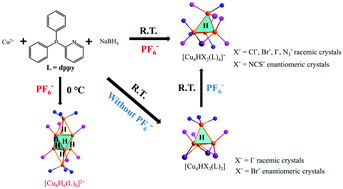Dissection of bicapped octahedral copper hydride cluster to form two chiral tetrahedral copper hydride cluster series exhibiting auto deracemization and photoluminescence†
Abstract
Three series of copper hydride clusters [Cu8H6L6]2+ (1), [Cu4HX2L4]+ where X− = Cl− (2a), Br− (2b), I− (2c), N3− (2d) and SCN− (2e), and [Cu4HX3L3] where X− = Br− (3b) and I− (3c) (L = 2-(diphenylphosphino)pyridine, dppy) were synthesized and characterized by single-crystal X-Ray crystallography and standard spectroscopic techniques. The metal core of 1, Cu8, can be described as a bicapped octahedron, while those of 2 and 3 series adopt tetrahedral structures. The hydride positions were deduced from difference electron density maps and corroborated by NMR and DFT calculations. For 1, there are two μ4-H−, one each in the two tetrahedral cavities of the two capping atoms and four μ3-H− on the six triangular faces around the waist of the octahedron. For [Cu4HX2L4]+ and [Cu4HX3L3] series, the single μ4-H− resides in the center of the Cu4 tetrahedron. It was found that these three series of copper clusters are intimately connected and can convert from one to another under specific reaction conditions. Their transformation pathways were investigated in detail. Spontaneous resolution to form optically pure enantiomeric single crystals was observed for [Cu4H(SCN)2L4]+ (2e) and [Cu4HBr3L3] (3b). Photoluminescence was observed for [Cu4HX2L4]+, as well as [Cu4HX3L3] with strong emissions from green to yellow regions.



 Please wait while we load your content...
Please wait while we load your content...